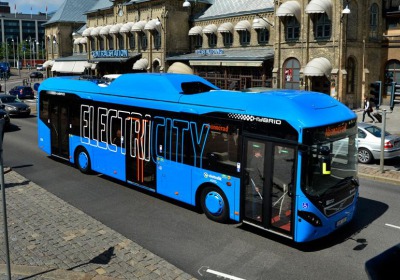Volvo Group plans wirelessly charged bus line
Tue, 20 May 2014
There's one bit of futuristic transportation technology that seems to get trotted out almost as often as autonomous cars, electric cars and flying cars: Inductive, or wireless, charging for city buses.
It's not as sexy or as memorable as the perpetually out-of-reach commuter-grade Harrier jet, but it uses proven technology (GM's EV-1 uses inductive charging, as do electric toothbrushes) to save or eliminate fuel and to reduce emissions.
And unlike the flying car, induction-charged buses are hardly fantasy: They've been used in European cities for over a decade, South Korea started testing a fleet last year and Utah got in on the act recently.
Even Milton Keynes, the English city better known as the home of Red Bull's Formula One team, will field a few of the buses on a 15.5-mile test route.
So what makes Volvo Group's recently announced attempt different? Nothing, really -- except that Volvo's flirtation with the technology means one of the world's largest truck/bus-builders (Volvo Group shares its logo with the Chinese-owned automaker, but its operations are separate) is getting in on the inductive action.
Volvo has already experimented with a series of plug-in hybrid “Hyper Buses” in use in the Swedish city of Gothenburg, but cutting the cord would let hybrid buses run greater distances before fuel-burning motors kicked in. Potentially, this technology could even allow electric-only operation.
The ins and outs of wireless power transfer -- the basis of inductive charging -- are fairly simple. Pump current into a coil of wire and you can induce a current in another coil, potentially one some distance away. In an inductively charged bus, powered “primary” coils could be located at bus stops or along stretches of road. The secondary coils are on the buses themselves; they can be used to charge batteries (or, potentially, other energy storage devices like capacitors) or directly run electric motors.
So, what's the catch? An article in the Institute of Electrical and Electronics Engineers' magazine, IEEE Spectrum, dissected some of the challenges presented by inductive charging and discussed why such a seemingly elegant technology hasn't been widely adopted. The main obstacle is efficiency: the bigger the air gap between charging surfaces, the less efficiently power is transferred.
But since buses follow regular routes that include many stops, there's no reason they can't get close to charging plates at regular intervals. And that's why Volvo's efficient mass-transit proposal (along with the similar pilot programs already in action across the globe) makes sense.
If all goes according to plan, Volvo Group will build a 300- to 500-meter (roughly 1000 to 1640-foot) strip of electric road in central Gothenburg as early as 2015. This should complement Volvo's upcoming all-electric “ElectriCity” bus line, allowing the company to study the benefits and drawbacks of wireless charging as it applies to heavy vehicles.
No world on whether the automaker operating under the Volvo name will gain anything from the experiment, but the prospect of self-charging autonomous cars would answer the prayers of innumerable commuters.
By Graham Kozak

